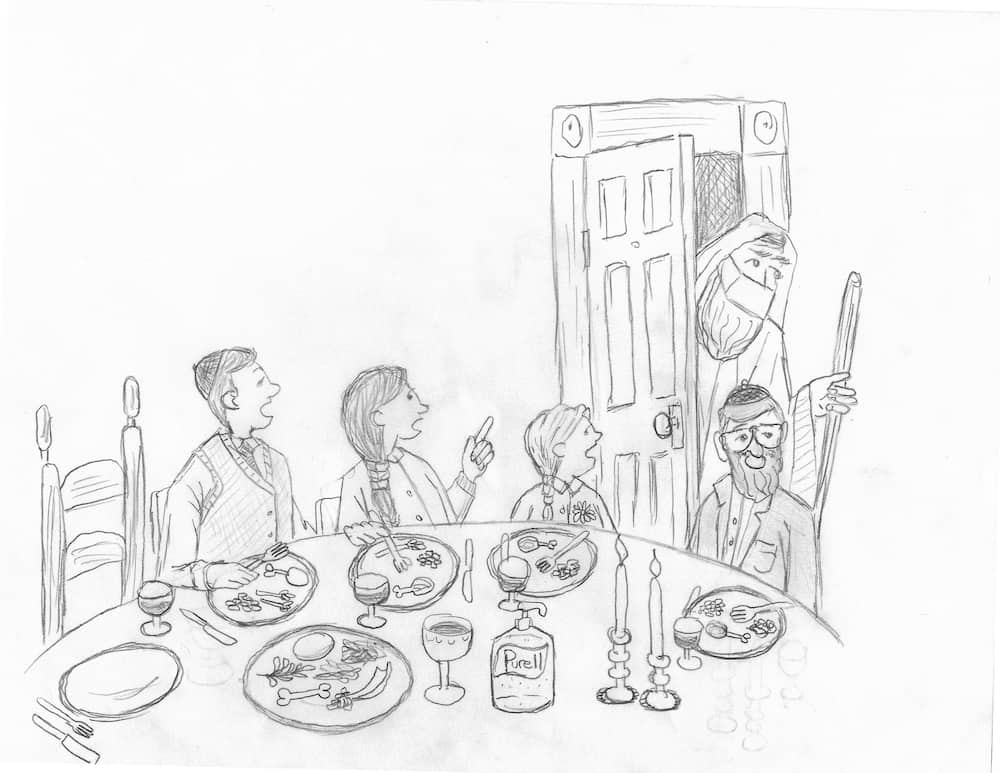
Passover is a time for gathering in the Jewish community. Families come together for the festive meal, and invite friends who are alone. Synagogues host communal Seders. Friends away from their families get together to observe and celebrate (and eat.)
Passover takes place from sundown on March 27th to sundown on April 4th, 2021. Traditionally a Seder is held the first two nights, although it can be held other nights as well.
Being together is such an important part of Passover, that it’s a tradition to invite strangers. Can’t find a stranger? At one point in the Seder, a participant opens the door to invite the prophet Elijah in for a sip of wine. There’s even a glass of wine put on the table for him.

Seder by Videoconference?
Are you still unable to gather with extended family for a Seder?
It’s not unheard of for people to use videoconferencing to share a celebration with far-flung friends and relatives, but this year it will be done on an unprecedented scale.
Two popular video call platforms are Zoom and Google Hangouts, and both would work fine. We have provided a getting started guide to both Zoom and Google Hangouts.
Do not make your invite public (for instance, in a public Facebook event.) There have been instances of people crashing and disrupting Zoom meetings, for no good reason. Just send the invite in an email or private message.
It’s tricky to use technology for the Seder, because there are Jewish laws that govern the use electronics on holidays like Passover.
Jews with different practices of observance will also have different levels of concern about using electronics during the Seder.
Please consult your own Rabbinic authority to verify that what you’re planning is consistent with your practice and belief.
However, some Jewish authorities have suggested:
- Activating the Zoom meeting before sundown (keeping in mind the time zones of all who are participating)
- Using a virtual assistant, like Siri or Alexa, to activate the stream
See Streaming Seder, from The Rabbinical Assembly.
Downloadable Haggadah
The Haggadah is the book that guides participants through the Seder. The word Haggadah means “telling,” as it tells the story of the Exodus from Egypt.
You can purchase a Haggadah, but there are countless versions that you can download and print, for personal use. Here are a few:
- Hebrew/English Haggadah, from Chabad
- The Passover Haggadah (in English) from Jewish Federation
- Coloring Book Haggadah
- Contemporary Haggadah from JewishBoston
- Build-Your-Own Haggadah
Passover Basics
Passover is a festival of freedom. It commemorates the Exodus from slavery in Egypt, under the leadership of Moses, following the Ten Plagues.
The items on the Seder plate each represent something about that story. Here’s a very brief description of each of those objects. If you google, you will certainly find other interpretations of the symbolism of each of these objects.
- Shank bone (zeroa): a roasted bone that represents the Paschal (lamb) sacrifice made by the ancient Hebrews.
- Boiled/roasted egg: stands in place of a sacrificial offering performed in the days of the Second Temple
- Maror (bitter herb): Horseradish is commonly used, but any bitter herb will work. It refers tot he bitterness of slavery.
- Charoset: A sweet mixture of apples, nuts, wine and cinnamon, that represents the mortar the Hebrew slaves used to make bricks
- Karpas: A green vegetable, usually parsley, symbolizing the freshness of spring.
- Hazaret: A second bitter herb, with the same symbolism as Maror.
Other elements of the Seder that you might have heard about:
- 4 glasses of wine (or juice) are consumed by participants.
- Matzah, unleavened bread, is a big part of Passover. It reminds us of the haste with which the Jews left Egypt.
- The Afikomen is a piece broken off from the matzah during the Seder. Many families’ traditions call for it to be hidden. Then, the children look for it, and return it for a reward. There are other variations of this tradition. For instance, in some families, the children steal it and ransom it for a reward.
- The 4 questions: traditionally, the youngest child recites the “4 questions,” which cover the basics of why Passover is special and important.
Free Passover Recipes
After the telling of the Exodus story is over, and the Haggadah is (mostly) finished, dig into the festive meal.
Some traditional items are:
- Brisket
- Roasted chicken
- Matzah ball soup
- Potato kugel
- Apple cake
Find free Passover recipes at:

Leslie Stewart says
My daughter just spent $32.95 on shipping (from NY) on $31.00 worth of Passover food (2 boxes matzoh, 1 can macaroons and one other thing) because she wasn’t able to get them here via “long distance shopping”.